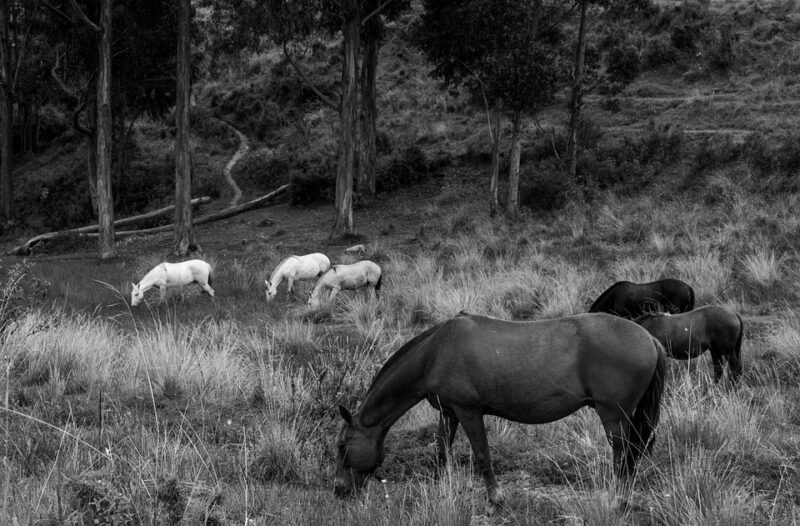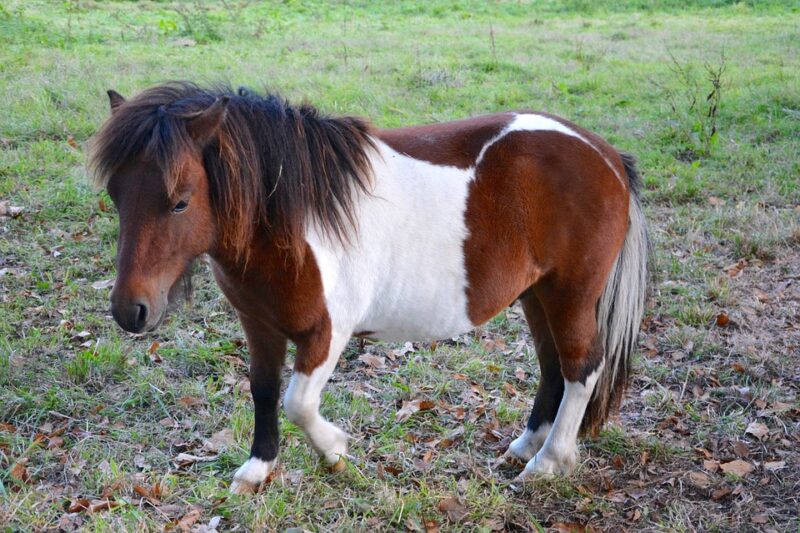Movement, or locomotion, is the way that horses get from place to place. Along with feeding, these are the behaviors that come to mind immediately when most of us think about horses: horses walking, running, and jumping either in the wild, at liberty in the pasture, or undersaddle.

As a natural behavior, locomotion is central to horse biology and good health. All equids are adapted for near-constant movement; they walk slowly as they graze, and they spend almost all their time grazing. As prey animals, they have to flee suddenly at great speed – the fastest horses have been clocked at around 50mph for short sprints, and the average gallop for a domesticated horse is about 27 mph.
Moving keeps a horse physically healthy; it is important for joint and hoof health, digestive wellness, muscle condition, and overall metabolism. The ability to move around is also vital to mental and emotional wellbeing, as the much higher incidence of stereotypical and coping behaviors (often referred to as stable vices) in stalled horses indicates.
Wild horses travel great distances because they have to do so in order to acquire the resources they need – to find enough good grazing, water, and safe areas to survive. Domesticated horses still have the need for travel – physically and mentally – of their ancestors, but tend to have much more sedentary lives than their wild counterparts. Even horses that are turned out 24/7 have only to walk from their forage supply to their shelter to their water in order to meet most of their immediate needs. And horses that are stalled for part or all of the day have a drastically reduced ability to cover ground.
Enriching Equines believes that the best way to encourage adequate locomotion is through full turnout into appropriately designed pasture spaces, rather than stalling. A stall can be filled with items that encourage other behaviors and keep a horse occupied, but it is largely impossible to promote true locomotion within a stall setting. For this reason, confinement and movement can be considered mutually exclusive. Every opportunity should be given to ensure that horses have an almost constant ability to move in large spaces, ideally within a herd.
However, even in with full access to ample pasture, many horses don’t engage in as much movement as would be best for them. Some horses are “standing sedentary” for much of the day, either for lack of anything else to do or because their environment is designed in a way allows them to be stationary for long periods. Within a pasture or paddock environment, there are plenty of enrichment options available to get horses moving and encourage more natural patterns of locomotion.
Walking While Grazing
This kind of movement occurs while horses graze, and usually involves the horse taking one or two shuffling steps at a time while moving from one clump of grass to another.
If horses don’t have access to forage on the ground – such as natural grass – then they don’t have the opportunity to engage in this very healthful behavior. Walking with the head down stretches the horse’s back through its whole topline, and appears to be soothing and relaxing to horses.

To encourage this low-intensity, calming activity, try Tiny Haystacks or placing many small scoops of grain at intervals around the pasture, in small bowls or on mats.
Walking for Destination
Horses walk at about four miles an hour. Humans walk at about three to four miles per hour on average, so when compared to the speed of their faster gaits, the walk is a very slow and energy-saving activity for a horse.
Horses walk to reach a destination when they are seeking a resource they know may be found somewhere other than where they are now. Unlike walking while grazing, where the horse has what it needs right at its nose, horses often need to simply walk from place to place to get water, seek shelter, or find a better patch of forage.

To encourage walking for destination, place resources (such as water troughs, shelter structures, and food locations) at greater intervals in the pasture rather than close together. You can also take a sensory walk with your horse and provide them with engaging sights, smells, and sounds while getting in some valuable locomotion. The track paddock system is probably the most intensive, yet highly effective, way of ensuring horse locomotion.
Remember that enrichment is about encouraging natural behavior. As much fun as riding is for many of us, saddling the horse and going for a trail ride, or lunging in an arena, isn’t enrichment – it’s exercise. While keeping a horse fit an exercised is often a very good idea and promotes physical health, enrichment is about encouraging the horse to use their bodies and minds on their own. Using positive reinforcement training and a fully cooperative and force-free approach can create opportunities to encourage walking, and faster gaits, in a way that is truly voluntary for the horse. The reverse round pen is a great example of exercise trained using reward-based principles.
The Faster Gaits
The trot, canter, gallop, and faster gaits of the gaited breeds are all natural behaviors. In wild or feral horses, fast gaits occur when the horse or the whole herd needs to move quickly, often to escape a predator. However, horses also run when seeking an especially desirable resource, to engage in urgent social matters (as in a stallion charging an interloper to defend his harm, or young horses running to greet one another and play), and occasionally just for the fun of it. Running doesn’t occur as often as walking, eating, and resting, so encouraging it less frequently as part of your enrichment program is fine.
You can encourage fast gaits by turning out the horse in a special location such as an arena, complete with their favorite enrichment items – many horses will trot and buck and have a great time. Training some speedy behaviors using positive reinforcement, such as the reverse round pen and fast recall from the pasture, can get a horse moving quickly for short periods. For the more adventurous, riding alongside other horses at liberty can encourage the nonridden horses to travel alongside the ridden one, up to a gallop if desired.
Sources
Meyer, Jennifer. What’s the Fastest a Horse Has Run? Horse and Rider, 2020